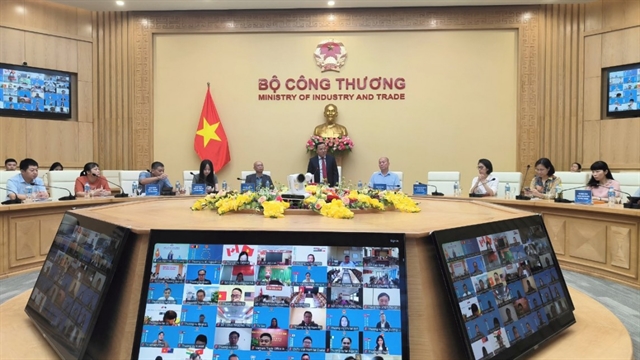 Economy
Economy

 |
| The monthly trade promotion conference is held by the Ministry of Industry and Trade in Hà Nội on July 2. — Photo baotintuc.vn |
HÀ NỘI — Trade promotions should prioritise key products and markets to increase imports and exports in the second half of this year, the monthly conference at the ministry heard.
Vũ Bá Phú, director of the Trade Promotion Department, at the Ministry of Industry and Trade (MoIT), made the proposal at their monthly meeting in Hà Nội on July 2.
Phú said in the second half of the year, the ministry would continue to innovate trade promotion activities, focusing on promoting digital transformation and connecting local businesses and their products, especially agricultural and aquatic products, to the Việt Nam trade offices abroad.
At the same time, they would coordinate closely with each other in implementing trade promotion programmes to improve efficiency in these programmes.
In addition, they needed to coordinate with localities, commodity associations and businesses to propose and develop plans on implementing trade promotion activities to expand import and export markets and digital transformation in trade promotion under the strategies and projects approved by the Prime Minister.
In the last six months of 2024, Việt Nam's export market would continue to have new requirements for international trade, more market barriers, trade protections, green transformation factor and focus on healthy product groups and organic products.
Changes in the world and regions would bring both advantages and disadvantages for trade activities, posing many new requirements for trade promotion.
"Therefore, supporting localities, associations and businesses in developing the export market and improving import and export situation in the second half of the year is a very important task of the industry and trade sector," Phú said.
The representative of the Department of Trade Promotion said that in the first half of this year, the global economy and trade showed many signs of positive recovery. However, difficulties and challenges were still here, including trade decline, geopolitical instability and inflation in many countries.
In that context, Việt Nam's economy was assessed to continue to be a bright spot in the world with the macro economy and Vietnamese businesses achieving many significant results in both domestic and foreign trade markets.
Exports continued to grow each month, maintaining the trade surplus. Agricultural production was stable, while industrial production recovered well. Exports of many agricultural products increased sharply.
Phú also assessed that during the first six months, the trade promotion activities contributed to connecting the businesses with domestic and foreign markets in consumption of their products, effectively supporting the businesses in exploiting and searching for export markets and strengthening links between production and consumption.
The trade promotion activities would combine traditional models with modern ways, associated with e-commerce and digital economy.
They would raise awareness in the business community about green transformation and sustainable production, to support for the businesses in improving their competitiveness and adapting to market trends.
Trần Thanh Hải, deputy director of the MoIT's Import-Export Department, said according to inter-ministerial statistics, total trade turnover of goods was estimated at US$369.6 billion in the first half of this year, up 16 per cent over the same period last year. Of which, exports were at $189.5 billion, up 14.2 per cent, imports were at $180.2 billion, up 18.1 per cent.
Hải also emphasised that a number of factors had been promoting the recovery of import and export activities, such as results from the policy of international economic integration and diversification of export and import markets due to new generation free trade agreements signed between Việt Nam and its partners.
Along with that, the Government had many solutions on comprehensively supporting the economy. MoIT also identified difficulties and risks from the export markets to propose solution on development of the export market.
High inventories in markets were gradually easing, especially in key export markets such as the EU and the United States.
The global economy in 2024 still faces many risks, according to Hải. The fight against inflation is still ongoing in many countries. The problem of excess capacity in China will also increase competitive pressure in the global market when it promotes goods export to other countries.
To increase exports, according to Đặng Thị Thanh Phương, Việt Nam Trade Counselor in Germany, the businesses need to meet new requirements of the import market. To meet mandatory minimum requirements of the market, buyers will also have specific requirements for each type of product.
The businesses also need to take advantage of the EVFTA to access distribution channels in Germany, especially distribution channels for Asian goods.
According to the representative of the Việt Nam Trade Office in Canada, the tariff advantages from CPTPP for Vietnamese exports have gradually reduced, because Canada has and is promoting the signing of free trade agreements with a series of partners in South America and the Indo-Pacific region such as Malaysia, India, Indonesia, and ASEAN bloc.
This trend is negatively impacting the export of some Vietnamese key export products such as fruits, seafood and textiles.
Due to losing the tariff advantages, Việt Nam's export products face high domestic logistics costs in Canada, making Vietnamese products' export prices less competitive compared to the products from neighbouring South American countries.
Therefore, in the future, the trade office will also focus on introducing the database of Việt Nam's industrial enterprises, as well as each specific enterprise on the English website to promote communication about Vietnamese enterprises. — VNS




